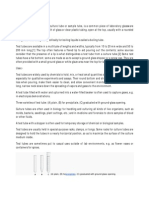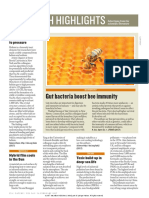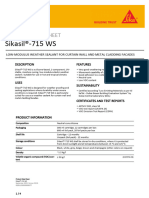Do Not Give Accurate Measurements But Give Precise Measurements
Do Not Give Accurate Measurements But Give Precise Measurements
Uploaded by
ashCopyright:
Available Formats
Do Not Give Accurate Measurements But Give Precise Measurements
Do Not Give Accurate Measurements But Give Precise Measurements
Uploaded by
ashOriginal Description:
Original Title
Copyright
Available Formats
Share this document
Did you find this document useful?
Is this content inappropriate?
Copyright:
Available Formats
Do Not Give Accurate Measurements But Give Precise Measurements
Do Not Give Accurate Measurements But Give Precise Measurements
Uploaded by
ashCopyright:
Available Formats
Test Tube
- aka culture tube or sample tube – bakit? because test tube are only used for testing chemicals,
mixing boiling and observing kumbaga, sample lang talaga. Culture- kase ginagamit din siya na
home for microorganisms pag gusto ng mga taong palakihin sila.
- It is a common piece of laboratory glassware
- Finger like length (u shaped bottom) of glass or clear plastic tubing, has a open top. It's essentially
a cylinder-like piece of equipment with one open end. There are many reasons for why test tubes
are made out of glass or special types of plastic. That's because they possess some advantageous
characteristics, such as being leak proof (so long as the tube doesn't break, of course).
Glass and special plastic test tubes are also non-reactive. Many metals react with all sorts of
chemicals in either dangerous ways or in ways that would ruin an experiment or sample. Test
tubes are also clear. It's kind of hard to see what you're doing with an experiment if the tube is
made out of wood, metal, or stone, isn't it?s
- Test tubes are for general chemical work usually made from glass, for better resistance to heat and
corrosive chemicals – dangerous
- made from expansion resistant glasses- borosilicate glass (fused quartz) -glass consisting of silica
in amorphous form. Can withstand high temperature up to several hundred Celsius
- ranging from 10-20 mm wide and 50-200 mm long
- top features a flared lip- to aid pouring out the contents
- usually flat bottom, round bottom, conical bottom
- spherical bottom and vertical sides reduces mass loss when pouring
- Widely used to hold, mix, or heat small quantities of solid or liquid chemicals. make them easier to
clean, and allow convenient monitoring of the contents. The long, narrow neck slows down the
spreading of vapours and gases to the environment.
- Convenient containers for heating small amounts of liquids and soids w/ use of Bunsen burner or
alcohol lamp, held by its neck with a clamp or tongs by tilting the tube. The bottom can be heated
to hundred degrees in the flame while neck remains relatively cool, possibly allowing vapors to
condense on its walls-gas to liquid
- Rubber stopper for temporary storage of chemical or biological samples.
- Bioscience- for handling and culturing all kinds of living organisms; bacteria, molds, seedings,
plant cuttings
- Culture tubes clear plastic (polystyrene or polypyrene) often discarded after use
- Plastic test tubes with a screw top cap are often called “falcon tubes”
- Sterile test tube with air removed, called vacutainers are used to collect and hold samples of
physiological fluids; blood, urine (commonly sealed with a rubber stopper)
- pptx
- Widely used by chemist to handle chemicals (also biosciences and clinical medicine)
- The long narrow neck slows down the spreading of gases to the environment
- Convenient for heating small amount of solids and liquids
- A test tube with a stopper is often used for temporary storage
- Do not give accurate measurements but give precise measurements- Accuracy refers to the
closeness of a measured value to a standard or known value. Precise- exact
- also known as culture tube or sample tube
- used to mix, heat or store substances
- Consisting a finger- like length of glass or clear plastic tubing
- Usually made from glass; expansion resistant glasses- borosilicate glass
- Usually flat bottom, round bottom and conical bottom
- Test tubes are sometimes put to casual uses outside of lab environments, e.g. as flower vases,
glassware for certain weak shots, or containers for spices.-add info
You might also like
- Marine PurifierDocument30 pagesMarine PurifierJayDelosSantos100% (1)
- ApparatusDocument10 pagesApparatusAngel Shane Vercide SilorioNo ratings yet
- Laboratory Apparatus and Its FunctionDocument4 pagesLaboratory Apparatus and Its FunctionTrese ShanelleNo ratings yet
- W1 L5 - Laboratory ApparatusDocument23 pagesW1 L5 - Laboratory ApparatusSaba OsamahNo ratings yet
- Laboratory Equipment Apparatus and GlasswareDocument3 pagesLaboratory Equipment Apparatus and Glasswarealvarez.joshua030No ratings yet
- 02 Unit 1. Common Laboratory GlasswaresDocument59 pages02 Unit 1. Common Laboratory GlasswaresKevin Mark IlaganNo ratings yet
- CrucibleDocument10 pagesCrucibleAlegna PalenzuelaNo ratings yet
- KumiDocument29 pagesKumimonike07No ratings yet
- BEAKERS Are Made Up of TemperedDocument12 pagesBEAKERS Are Made Up of TemperedmnmrznNo ratings yet
- Laboratory ScienceDocument15 pagesLaboratory Scienceedlynpags34No ratings yet
- Laboratory Equipment Flame Brass Glass Stainless Steel AluminiumDocument9 pagesLaboratory Equipment Flame Brass Glass Stainless Steel AluminiumKenneth P PablicoNo ratings yet
- Protective Eyewear Chemicals EyesDocument2 pagesProtective Eyewear Chemicals EyesMotorx GpaNo ratings yet
- JVC Laboratory Activity 1Document34 pagesJVC Laboratory Activity 1Jade CagsawaNo ratings yet
- List of Chemistry Laboratory Apparatus and Their UsesDocument20 pagesList of Chemistry Laboratory Apparatus and Their Usesdexter timbanganNo ratings yet
- Know Your Lab Equipments: Test TubeDocument9 pagesKnow Your Lab Equipments: Test TubeWelly Boss HwiNo ratings yet
- Laboratorio 1Document29 pagesLaboratorio 1Dennis OlazabalNo ratings yet
- GENERAL CHEMIST-WPS OfficeDocument4 pagesGENERAL CHEMIST-WPS OfficeYra kyranNo ratings yet
- Maintaining Accuracy and PrecisionDocument6 pagesMaintaining Accuracy and PrecisionAkshit ParmarNo ratings yet
- Test Tube Function and Uses With Diagram - Guidance CornerDocument7 pagesTest Tube Function and Uses With Diagram - Guidance CornerZeroseveen SeveenNo ratings yet
- Chem Lab - Prelims ReviewerDocument2 pagesChem Lab - Prelims ReviewerJuliannaViktoriiaNo ratings yet
- GlasswareDocument54 pagesGlasswareSwagath NNo ratings yet
- Appendix A List and Uses of ApparatusDocument3 pagesAppendix A List and Uses of ApparatusayraNo ratings yet
- Common Laboratory ApparatusDocument2 pagesCommon Laboratory ApparatusAngelica Joy FloresNo ratings yet
- Lab0ratory Equipment and ToolsDocument40 pagesLab0ratory Equipment and ToolsJane Anda100% (1)
- Laboratory Apparatus and Their UsesDocument5 pagesLaboratory Apparatus and Their UsesKevin Tan80% (5)
- LaboDocument36 pagesLaboFiroj Alam50% (2)
- Chemistry Laboratory EquipmentsDocument11 pagesChemistry Laboratory EquipmentsEliutario Ignacio100% (1)
- Lab Safety and EquipmentDocument33 pagesLab Safety and EquipmentGábor PatakiNo ratings yet
- 1ST Sem Gen ChemDocument6 pages1ST Sem Gen ChemJhoy BautistaNo ratings yet
- Good Lab Practices, Lab Saftey, LabDocument54 pagesGood Lab Practices, Lab Saftey, LabmukunddindawarNo ratings yet
- Chem Lab 1 Itlog AssignmentDocument2 pagesChem Lab 1 Itlog Assignmentfamigo451No ratings yet
- Document 1Document1 pageDocument 1vbalaramnavarNo ratings yet
- Lab Activity #2Document4 pagesLab Activity #2ROLDAN, KURT DAVID L. BSMT 2-6No ratings yet
- Laboratory Apparatus and Equipment - 231030 - 192238Document2 pagesLaboratory Apparatus and Equipment - 231030 - 192238alyespina16No ratings yet
- Common Laboratory ApparatusDocument3 pagesCommon Laboratory ApparatusDomingo F. Combate Jr.67% (3)
- Experiment # 2 MicrolabDocument8 pagesExperiment # 2 Microlabdaniella evangelistaNo ratings yet
- Laboratory Apparatus and Their UsesDocument3 pagesLaboratory Apparatus and Their UsesmarellagabrielNo ratings yet
- Laboratory EquipmentDocument7 pagesLaboratory EquipmentBhojNo ratings yet
- ChemDocument3 pagesChemjethroanthony.deitaNo ratings yet
- ?zbn7ig4fj - Lab Activity (Jamaikie Ramos 1D)Document6 pages?zbn7ig4fj - Lab Activity (Jamaikie Ramos 1D)maikie.ramos29No ratings yet
- Ana Video 1Document6 pagesAna Video 1Lu'lu Abdi Aziiz HassanNo ratings yet
- Biochem Lab NotesDocument38 pagesBiochem Lab Notesjshaymin8No ratings yet
- BeakerDocument5 pagesBeakerLerma Asegurado ReyesNo ratings yet
- Alcohol Burner or Spirit Lamp Is A Piece of Laboratory Equipment Used To Produce An Open FlameDocument5 pagesAlcohol Burner or Spirit Lamp Is A Piece of Laboratory Equipment Used To Produce An Open FlameEllen PabitonNo ratings yet
- Laboratory EquipmentsDocument10 pagesLaboratory Equipmentsjazmiah18100% (2)
- Acn Laboratory ApparatusDocument40 pagesAcn Laboratory ApparatusAlma Cecilia QuiaoNo ratings yet
- Labaratory EqDocument1 pageLabaratory EqAnonymous MyMFvSmR100% (1)
- Science Lab Equipment ListDocument21 pagesScience Lab Equipment ListVijay GangeNo ratings yet
- 1.analytical Balance Description:: MG Dust Vented Balance Safety EnclosureDocument10 pages1.analytical Balance Description:: MG Dust Vented Balance Safety EnclosureJeck AbañoNo ratings yet
- Apparatus Description UsesDocument6 pagesApparatus Description UsesVenus De GraciaNo ratings yet
- Laboratory Apparatus and Their UsesDocument7 pagesLaboratory Apparatus and Their Uses星山じびつNo ratings yet
- Glassware and PlasticwareDocument23 pagesGlassware and PlasticwareAmna ZafarNo ratings yet
- Laboratory EquipmentsDocument16 pagesLaboratory EquipmentsedomanpcNo ratings yet
- Laboratory ApparatusDocument3 pagesLaboratory ApparatusLJ Princess Mary MontenegroNo ratings yet
- Laboratory Educational 2Document4 pagesLaboratory Educational 2Rhzyl Moira CadapNo ratings yet
- Bunsen BurnerDocument17 pagesBunsen BurnerMaiza TiborNo ratings yet
- Lab EquipmentsDocument10 pagesLab Equipmentschouroukbelkacemi236No ratings yet
- Chemistry Lab Mysteries, Fun Laboratory Tools! Chemistry for Kids - Children's Analytic Chemistry BooksFrom EverandChemistry Lab Mysteries, Fun Laboratory Tools! Chemistry for Kids - Children's Analytic Chemistry BooksRating: 5 out of 5 stars5/5 (1)
- Laboratory Manual of Glass-BlowingFrom EverandLaboratory Manual of Glass-BlowingRating: 5 out of 5 stars5/5 (2)
- Section Cutting and Staining: A practical introduction to histological methods for students and practitionersFrom EverandSection Cutting and Staining: A practical introduction to histological methods for students and practitionersNo ratings yet
- Slowing the March of Time Preserving and Protecting Items Of Historical SignificanceFrom EverandSlowing the March of Time Preserving and Protecting Items Of Historical SignificanceNo ratings yet
- Music SummaryDocument5 pagesMusic SummaryashNo ratings yet
- Cellular Respiration Is A Set of Metabolic Reactions and Processes That TakeDocument8 pagesCellular Respiration Is A Set of Metabolic Reactions and Processes That TakeashNo ratings yet
- DNA Replication: Name: Section: ScoreDocument2 pagesDNA Replication: Name: Section: ScoreashNo ratings yet
- Facilitated Diffusion Is The Process of SpontaneousDocument3 pagesFacilitated Diffusion Is The Process of SpontaneousashNo ratings yet
- Number Problem:: Therefore, The Consecutive Positive Numbers Are 15 and 16Document7 pagesNumber Problem:: Therefore, The Consecutive Positive Numbers Are 15 and 16ashNo ratings yet
- Graph of Quadratic FunctionsDocument26 pagesGraph of Quadratic FunctionsashNo ratings yet
- Impression, Soleil LevantDocument6 pagesImpression, Soleil LevantashNo ratings yet
- Noli Me Tangere 1Document128 pagesNoli Me Tangere 1ashNo ratings yet
- Covalent Ionic: Forms MoleculesDocument1 pageCovalent Ionic: Forms Moleculesash100% (1)
- 1st Q MusicDocument2 pages1st Q MusicashNo ratings yet
- Research Highlights: Gut Bacteria Boost Bee ImmunityDocument1 pageResearch Highlights: Gut Bacteria Boost Bee Immunityferonica chungNo ratings yet
- Horizontal Tube EvaporatorDocument16 pagesHorizontal Tube EvaporatorFarzana IslamNo ratings yet
- Class 9 Chapter 2Document5 pagesClass 9 Chapter 2chughzeniaNo ratings yet
- Vertical 2 PhaseDocument4 pagesVertical 2 PhaseSterling GordianNo ratings yet
- Mechanical Integrity:: Fixed Equipment Standards & Recommended PracticesDocument36 pagesMechanical Integrity:: Fixed Equipment Standards & Recommended Practicesah1525100% (1)
- PhET Phototelectric Effect QuDocument9 pagesPhET Phototelectric Effect QuaaaaNo ratings yet
- Composition of SoilDocument29 pagesComposition of SoilAbigail Pia Mae NovoNo ratings yet
- Oil Tank CleaningDocument4 pagesOil Tank CleaningMituNo ratings yet
- Northern Blotting SsDocument11 pagesNorthern Blotting Ssrck46No ratings yet
- 3 Effects of Electric Current Physics ProjectDocument20 pages3 Effects of Electric Current Physics ProjectAkshatNo ratings yet
- M&EUR210ENDocument3 pagesM&EUR210ENRizqi AchsanulNo ratings yet
- I .Polyethylene Duct and ConduitDocument42 pagesI .Polyethylene Duct and ConduitMuhammed Siddik100% (1)
- In This Section You Will Find Reagents and Equipment For:: Education Opportunity!Document8 pagesIn This Section You Will Find Reagents and Equipment For:: Education Opportunity!Moussa ToudjaniNo ratings yet
- Phenol, 2,2'-Methylenebis (6 - (1,1-Dimethylethyl) - 4-MethylDocument3 pagesPhenol, 2,2'-Methylenebis (6 - (1,1-Dimethylethyl) - 4-MethylcanishtainNo ratings yet
- The Real Trick To Drying Ceramic Ware Is To Use A Method That Removes The Water From The Inside of The Ceramic As Fast As The Surface Water Is EvaporatedDocument55 pagesThe Real Trick To Drying Ceramic Ware Is To Use A Method That Removes The Water From The Inside of The Ceramic As Fast As The Surface Water Is EvaporatedMiguel OcampoNo ratings yet
- Oil & Natural Gas Corporation LTD: Recruitment of Graduate Trainees 2010Document4 pagesOil & Natural Gas Corporation LTD: Recruitment of Graduate Trainees 2010ashidh666No ratings yet
- Sikasil 715 WsDocument4 pagesSikasil 715 WskhalidNo ratings yet
- STEM - General Biology 1 CG - 1Document4 pagesSTEM - General Biology 1 CG - 1Anonymous TsEj4WZ58% (12)
- HOW TO DESIGN AMMONIA REFRIGERATION PLANT USING AAR STANDARD 1 2016 by Ramesh ParanjpeyDocument7 pagesHOW TO DESIGN AMMONIA REFRIGERATION PLANT USING AAR STANDARD 1 2016 by Ramesh ParanjpeyMark Anthony CentenoNo ratings yet
- Improving The Efficiency of A Chilled Ammonia CO2Document7 pagesImproving The Efficiency of A Chilled Ammonia CO2ناصر احمدNo ratings yet
- Colorbond XRW Datasheet New V8Document2 pagesColorbond XRW Datasheet New V8Gireesh Krishna KadimiNo ratings yet
- CVDocument4 pagesCVRishi SrivastavNo ratings yet
- Protection With BocDocument4 pagesProtection With BocmanjujavagalNo ratings yet
- Ion Chromatography Filter SyringeDocument4 pagesIon Chromatography Filter SyringeDewi WulandhariNo ratings yet
- HSE Handout 3Document52 pagesHSE Handout 3hyNo ratings yet
- Prabhu Et Al 2018Document7 pagesPrabhu Et Al 2018B RAMUNo ratings yet
- Q3-W4B-Protein Synthesis (By Group)Document5 pagesQ3-W4B-Protein Synthesis (By Group)Catherine CantadaNo ratings yet
- Laboratory Exercise #2 - The Chemical Basis of LifeDocument4 pagesLaboratory Exercise #2 - The Chemical Basis of LifeRee YanaNo ratings yet


































































































